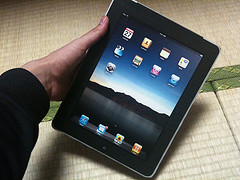Mar
31

Posted by Alison Aldrich on March 31st, 2010
Posted in: Technology

This Saturday, Apple will release its newest fancy gadget, the iPad. An estimated 150,000 iPads have already been ordered, and there is speculation that iPads will sell faster in the next few weeks than iPhones did when they were first released in 2007.
iPads are larger than iPhones or iPod touches, smaller and lighter than laptops, and frequently compared to netbooks, tablet PCs, and e-book readers such as the Amazon Kindle. Even with so many similar devices already on the market and in use, the iPad is generating a good deal of buzz in medical and research circles. According to one recent survey, 20% of current ePocrates users plan to purchase iPads very soon (ePocrates is a leading provider of clinical decision support tools for use on mobile devices). Another 50% of ePocrates users are interested enough in the iPad to request more information about it. Here are a few ideas about how the iPad might be used in research environments, hospitals, clinics, and doctors’ offices.
In clinical settings with secure wireless networks, healthcare providers could use iPads to access and update electronic health records (EHRs). Epic Systems has already launched an EHR iPhone application called Haiku. The iPad will be just about as portable as the iPhone, but with a larger, high-definition touchscreen. This will give iPad an advantage over smartphones when it comes to interacting with documents and dealing with radiographs and other detailed images. iPads could also be used to present patient education materials, such as diagrams and videos, at the point of care. The device has a battery life of about ten hours, so healthcare providers could get through most shifts without needing to recharge.
In the laboratory, a single iPad (they come with either 16, 32, or 64 GB of storage capacity) could hold all sorts of manuals, textbooks, and documents. Papers is a very popular document management application for the iPhone and iPod touch, and it will probably be adapted for the iPad soon. iPads could facilitate Open Notebook Science by giving researchers a convenient digital way to record lab notes. The iPad weighs about 1.5 pounds and is slightly smaller than a piece of notebook paper, so it would fit comfortably in most work environments. Questions remain about iPad’s durability. Is it spill proof/scratch proof, and can it be kept reasonably sterile? This remains to be seen.
Potential iPad users are already compiling lists of improvements they would like to see in the next iteration of the device. Many would like to be able to watch videos in the popular Flash format, but the first iPads will not support Flash. Unlike iPhones, iPads do not have built-in cameras, so they can not be used for video chat/telemedicine or for capturing photos in the laboratory and in the field. Document annotation will be possible with the iPad’s touch screen and on-screen keyboard. However, iPad does not work with a stylus, so circling and scribbling capabilities are less than optimal. Finally, all of the applications that run on the iPad (or iPhone, or iPod Touch) must be approved by Apple for the iTunes App Store. Some see this as positive because it provides quality control and it streamlines the ordering and downloading process. Others see it as a barrier to innovation.
Has there been any talk of iPads at your place of work yet? Will you be lining up at the Apple store on Saturday to try this gadget for yourself? Let us know in the comments.
For Further Reading:
iPad Features and Technical Specifications from Apple
How the Tablet Will Change the World from Wired magazine
Medicine is the Apple iPad sweet spot